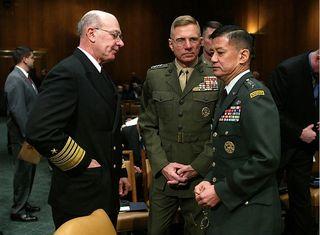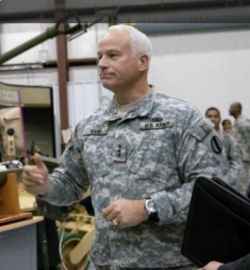Veterans Affairs Secretary Eric Shinseki is in the news and it's not the first time he's been center stage.
Students of the Iraq War may recall that at the start of the war, Shinseki, a four-star general, was the Chief of Staff of the Army who got into a public row with then-Secretary of Defense Donald Rumsfeld over troop strength. Shinseki said the US needed on the order of 250,000 troops in Iraq once the war wound down. In a clear rebuke, Rumsfeld and his deputy Paul Wolfowitz made it known that they disagreed and Shinseki was forced out of his post.
Ultimately, Shinseki's view was vindicated and supported across the aisle and in The White House.
It was precisely when this was happening in the spring of 2003 that Jeff Stamps and I came into contact with General Shinseki, something we neither planned nor ever imagined. We pulled that story together for an unpublished book, "Leading Networks," and, given Shinseki's prominence at the moment, I think it's worth retelling here.

General Shinseki, right, with Admiral Vern Clark, left, also mentioned below,
and Marine General Michael Hagee; photo from NY Times, 1/12/07
On February 10, 2003, I answered the phone and found an unlikely caller. "I'm calling on behalf of (then-) Major General Jim Dubik," he said. "He'd like you to come to a wargame."
Unified Quest 03, the aide explained, would be the first Joint Forces-US Army Wargame, a weeklong simulation that would take place at the Army War College in Carlisle, Pennsylvania. We would be among a small group of outsiders; the other 700 people would be from military forces both in the U.S. and among American allies and from defense contracting firms.
I said that I'd never heard of General Dubik. "Well, he’s heard of you", the aide replied, explaining that Dubik had read and been interested in The Age of the Network, a book we’d written ten years earlier.

Lt. Gen. Jim Dubik, now retired, photo from Penn State Dickinson School of Law site,
where he holds the Gen. Omar N. Bradley Chair in Strategic Leadership
Jeff was as flabbergasted as I when I went into his study to tell him.
We had met as anti-Vietnam War activists in 1968 while students at Oxford University.
In contrast to some of our friends in 2003 who argued with us, we strongly opposed the then-looming Iraq War.
We decided to attend.
And then we told our friends what we were planning to do. Invariably we got the same reply: “You’re going to be doing what?” Then quickly, nearly all followed with, “Thank God. I’m so glad you’re going.”
Thus began our involvement with the American military, particularly the Army, where we’ve discovered that some of its ideas, particularly in regard to leadership, are ahead of those we've encountered as consultants in the commercial and non-profit sectors.
To attend a wargame was beyond our ken. So it was with apprehension, curiosity, and a little discomfort that we went to the Carlisle Barracks, reflected in a summary I wrote after the event:
"My coming-in-picture of a 'wargame?' I thought it would be fought in a space the size of at least a basketball court, maybe even as large as the hangar I once toured at Douglas Aircraft where the MD-11 was being built.
"And, I wasn’t sure precisely what would transpire on this 'battlefield.' I thought it was unlikely that we'd find people playing laser tag or paintball, but I wasn’t even certain of that. I was unprepared for the wargame to be 'fought' in crowded conference rooms, where it was hard to hear what people were saying and where the commander’s back was usually turned toward most of those in the room."
The wargame that (now-retired Lieutenant General) Dubik invited us to—in this case, a thinly disguised confrontation with a country called “Nair” (unscramble the letters)—included our attending the daily debriefings for the “flag officer” (read highest-ranking officers) at the end of each day. There, the senior military strategists, many retired, would deconstruct the day’s wargame results.
Following the opening session at the War College’s Bliss Hall, which I remember as being very loud and filled with promotional videos for various weapons and tanks, Bill Rittenhouse, then a career staffer for the Army’s Training and Doctrine Command and an organizer of the event, found us stumbling around, unsure of what to do next or where to go. He welcomed us, indicating that he wasn’t quite certain what we were supposed to be doing either, but immediately introduced us to Clint Ancker, a retired colonel doing research on the Army’s structure and director of the famed Center for Army Lessons Learned.
We knew who Ancker was because one of his aides had been corresponding with us over the prior few months on “echelonment.” The word, from the French, literally means rungs on a ladder, and is the term the military uses to describe its levels of hierarchy.
Ancker and his group had been tasked with responding to a “request” from the then-Secretary of Defense. Now that the forces were “joint,” meaning that they all had to play nice together, Rumsfeld wanted the Army to remove a level, an echelon, from its traditional command structure, a rung near the top. Over lunch, Ancker drew some pictures about options for the Army’s reorganization, which reassured us that our expertise in networks had some relevance to what they were working on.
From that informative lunch, Ancker moved us along to meet then-Brigadier General (later Lieutenant General) Mike Vane, a self-described California beach boy in his youth, and one of the conference co-chairs.

Lieutenant General Mike Vane, now retired, photo from US Army site
Vane, in turn, took us into a small room to wait for General Dubik. “Hi, I’m Jim Dubik,” said the informally dressed general, extending his hand as he walked in.
After the usual pleasantries, we asked the central questions: “Why are we here and what do you want us to do?” Dubik responded in a way that we’ve become accustomed to in working with senior executives.
“I don’t know precisely,” he said. “I read your book about networks. We’re fighting a networked enemy. We have a net-centric warfare strategy in place. And we’re responding to the SecDef’s request for material on echelonment.”
Dubik told us to “wander around” and to try to absorb as much as we could as quickly as possible, and to reflect back what we noticed. He asked that we pay attention to “jointness” (how the separate forces worked together) and “echelonment,” in particular, but cautioned us not to artificially limit our scope.
These intriguingly broad terms of reference allowed us to follow an unscripted flow. After a tour of the wargame premises by one of Vane’s aides, we were, for the most part, left on our own.
Over the following week, we talked with dozens of people both formally and informally. We sat in on sessions where specific maneuvers were debated in snatches and at length. We shared meals with generals and admirals, trading health tips and nutrition theories with a four-star. We exchanged references with analysts, media, and advisors.
And, we attended the highest-level meeting of our lives, an “out-brief,” military-speak for what business refers to as a post-mortem, with the Joint Chiefs.
On the last day of the wargame, General Shinseki arrived to hear the conclusions of the exercises. It was one of the rare events that we weren't invited to but when it was over, the ground crew involved with putting on the event—the schleppers, the logistics people, and the sponsoring senior military officers, including Dubik and Vane—stood in a line as Shinseki spoke to them, thanking each individually.
Everyone knew what was happening—indeed, Shinseki's disagreement with the Bush administration over troop strength required in Iraq, an estimate that later proved to be entirely accurate, had been broadcast on television—and sadness seeped across the floor just beneath the evident respect that seemed to pour from people's eyes. Shinseki then walked down the line, pressing a medal commemorating the wargame into the hand of each person who'd worked the event. After the meet-and-greet, Dubik pressed one into each of our hands.
The next day, we drove south from Carlisle to Fort McNair in Washington for the “Senior Leaders Seminar,” the last event of this historic wargame. There, the generals and admirals who orchestrated the wargame, along with a handful of participants from the Carlisle exercises, met with the military's top brass, including the Chief of Naval Operations, the Vice Chief of Staff of the Air Force, and the Supreme Allied Commander of Atlantic, along with their peers—as well as the then-Deputy Secretary of Defense, Wolfowitz. Of the ninety guests, as best we could determine we were the only true civilians, and I was the only woman. We were seated just behind Wolfowitz and the Army Chief of Staff.
This gathering at the National Defense University took place the very day after then-President Bush landed on the USS Lincoln to proclaim “Mission Accomplished."
General Shinseki led the proceedings. Seated to his left was Wolfowitz, who arrived late and left barely ten minutes later, just moments after the briefing began. (An aide came in, handed him a note, and he said that he had to leave because "the Secretary needs me.")
Surely Wolfowitz could not have wanted to hear the words of one retired four-star Air Force general who said plainly, “Preemption does not work.” Preemption, the Bush administration policy employed in the Iraq War, the general said, violated the principles of war, left the enemy no choice but to respond with unconventional methods (meaning weapons of mass destruction), and placed the preempting forces without any of their conventional means of applying pressure incrementally.
This “After Action Review,” the systematic method the Army developed for reviewing its “actions,” included a ten-minute video positioning the history and chronology of this particular wargame, emerging issues identified by the wargame teams, and feedback from those participating.
We were told that this meeting was historic: It was the first time the highest levels of US military had convened as a network of peers for a wargame debriefing. Hot on the heels of the initial and what then appeared to have been the stunningly successful invasion of Iraq—reportedly the most "joint" operation in history—was “a not-to-be-missed opportunity,” which is how Admiral Vern Clark, then the Chief Naval Officer, described it to us as we were leaving.
The meeting lasted for a few hours; our involvement with the military lasted for another five years until the last of the crop of senior officers whom we knew retired.
What we took away was that while the “joint” approach to military affairs as practiced at this wargame is still being worked out, it is evident that the complexity of global relations in the 21st century demands it.
The immediate, mind-boggling dilemma of security in a pre-emptive, time-warped world with unpredictable enemies who have access to unthinkable weapons no longer allows individual and separate hierarchies to march forward.

